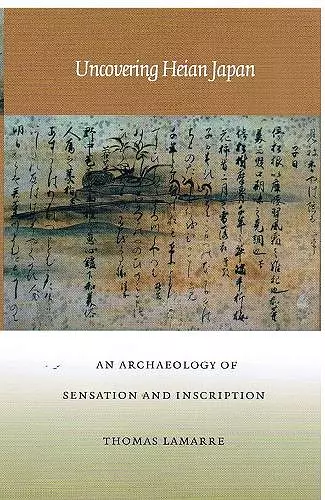Uncovering Heian Japan
An Archaeology of Sensation and Inscription
Format:Hardback
Publisher:Duke University Press
Currently unavailable, and unfortunately no date known when it will be back

Literary criticism of classical Japanese poetry, focusing on the emergence of Kokinwakashu,' an imperial anthology of waka poetry compiled in the 9th century."
The poetry of the Heian court of Japan has typically been linked with the emergence of a distinct Japanese language and culture. Combining visual analysis of the calligraphy with which this poetry was transcribed, a more traditional textual analysis, and a review of the politics of the period, this book presents a view of Heian poetry and culture.The poetry of the Heian court of Japan has typically been linked with the emergence of a distinct Japanese language and culture. This concept of a linguistically homogeneous and ethnically pure “Japaneseness” has been integral to the construction of a modern Japanese nation, especially during periods of western colonial expansion and cultural encroachment. But Thomas LaMarre argues in Uncovering Heian Japan that this need for a cultural unity—a singular Japanese identity—has resulted in an overemphasis of a relatively minor aspect of Heian poetry, obscuring not only its other significant elements but also the porousness of Heian society and the politics of poetic expression.
Combining a pathbreaking visual analysis of the calligraphy with which this poetry was transcribed, a more traditional textual analysis, and a review of the politics of the period, LaMarre presents a dramatically new view of Heian poetry and culture. He challenges the assumption of a cohesive “national imagination,” seeing instead an early Japan that is ethnically diverse, territorially porous, and indifferent to linguistic boundaries. Working through the problems posed by institutionalized notions of nationalism, nativism, and modernism, LaMarre rethinks the theories of scholars such as Suzuki Hideo, Yoshimoto Takaaki, and Komatsu Shigemi, in conjunction with theorists such as Derrida, Karatani, Foucault, and Deleuze. Contesting the notion that speech is central to the formation of community, Uncovering Heian Japan focuses instead on the potential centrality of the more figural operations of poetic practice.
Specialists in Japanese history and culture as well as scholars working in other areas of cultural criticism will find that this book enriches their understanding of an early Japan that has exerted so much influence on later concepts of what it means to be Japanese.
“‘The line,’ wrote William James, ‘is the relation.’ In a study of stunning originality, Thomas Lamarre gives us the brushwork line, the line of poetic gesture—and through it, the relation between nation and sensation. Uncovering Heian Japan combines an exquisitely researched archeology of Japanese writing with far-ranging reflections on race, nation, and collective expression. A major contribution not only to Japanese studies, but to the interdisciplinary realm of cultural theory as a whole.”—Brian Massumi, State University of New York at Albany
“A vivid reading of Heian court poetry that removes the interpretive screen later imposed in the name of national identity and modernity to reveal a richly expressive world. Here calligraphy, composition, and community combine in a ‘song machine’ that links poetics and politics and seeks, quite literarily, to calibrate the cosmos. After this book the poetry of ‘old Japan’ will never be the same.”—Carol Gluck, Columbia University
"Thomas LaMarre has written a fascinating archaeology of how the national imagination of modern Japan has colonized ancient scriptures of the archipelago to fabricate a glorious lineage and cultural ancestry for itself. Uncovering Heian Japan also recovers the rich prehistory of cosmopolitan poetic exchanges between the archipelago and the Middle Kingdom that is foreclosed by state-sanctioned cultural histories of both modern Japan and China."—Pheng Cheah, University of California, Berkeley
ISBN: 9780822324829
Dimensions: unknown
Weight: unknown
248 pages